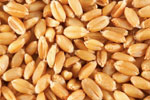Wheat Flour Recipes
Apple Cinnamon Bread
Banana Nut Bread
Banana Nut Muffins
Blueberry Muffins
Raisin Bran Muffins
Carrot Muffins
Cornbread
Cornbread Dressing
Orange Cranberry Muffins
Pumpkin Nut Muffins
Zucchini Bread
Whole Wheat Pizza Dough
Pizza Dough (Plain)
Four Grain Pancakes
Buttermilk Pancakes
Spice Pancakes
Pictures

Wheat in field.

Wheat grains.
Ingredient Information
Wheat Flours
Any grain that has been finely ground is technically a flour.
The most popular flour is all-purpose wheat flour, also known as white flour. It is manufactured by crushing wheat berries between large steel rollers. Most white flour is mass produced in industrial quantities with the production process taking place at high temperatures, which both destroys the wheat germ and removes the outer bran layer. All that is left is the endosperm. The result is the loss of many vitamins and nutrients.
Stone grinding is a slower process using large stones to crush the wheat so that the germ and bran are not lost as the flour is produced. This is the principal difference between white (no germ or bran) and wheat flour (germ, bran and endosperm).
Because the flour made by steel grinding no longer contains the germ, U.S. law requires that lost nutrients be replaced with iron, niacin, riboflavin and thiamine. Many manufacturers add other nutrients. This is how flour comes to be labeled “Enriched.” I like to add a little wheat germ back into my baked goods for the fiber and sweetness that has been removed from all purpose flour.
The proteins in flours (known as glutens) are the key to the character of a particular flour. These molecules form an elastic framework that traps gas (mostly carbon dioxide) formed by different leavening agents (such as baking soda or yeast).
White flours are usually made with a combination of a low gluten “soft-wheat” flour and higher gluten “hard-wheat” flour. Most have more gluten per ounce than whole wheat flour and, as a result, a greater ability to trap the gas formed by leavening agents. Consequently, breads made with white flours will rise further and be less dense.
Whole wheat flours are more nutritious because they contain most of the vitamins lost when making white flour. They are also higher in fiber (clearly important with what we now know about the importance if high fiber diets). The germ contains some fat and most of the vitamins, while the bran layer is mostly fiber. Because of the higher fat content, whole wheat flour doesn’t keep as well as white flour and will turn rancid over time.
Flour also bleaches naturally as it ages; as it does, the glutens mature. Ageing flour costs more money than bleaching with chemicals, so most of the flour on the market is chemically treated to simulate the ageing process. Unbleached flour will have more flavor but it can also be an inconsistent product, so try to purchase unbleached flour from the same miller.
1/4 cup enriched all purpose white flour = 112 calories, <1 fat, 0g sat fat, 0g mono fat, 3g protein, 24g carbohydrates, <1mg sodium, 0mg cholesterol, 0 mcg Vitamin K
1/4 cup whole wheat flour = 102 calories, <1 fat, 0g sat fat, 0g mono fat, 4g protein, 22g carbohydrates, <1mg sodium, 0mg cholesterol, 0 mcg Vitamin K
Related Articles
Habits of normal-weight people:
Researchers in Austin, Texas reported recently on the observed differences in dietary habits between 52 normal-weight people and 52 overweight people of the same sex, age, and height.
A roughage life....
We know that fiber can help prevent some cancers, reduce your cholesterol, help you avoid problems with heart disease and help diabetics control their blood sugar. Almost every week I read another positive study on how great high fiber foods are for your health.
Want to avoid gaining weight? Get more fiber!
We all know that losing weight by simply eating less can be a bit of a challenge. Researchers have been studying the effects of different elements of foods with the goal of finding ways for people to lose weight more successfully.
Eating Whole Grains May Help Prevent Age-Related Weight Gain
By now, you probably know that whole grains are better for you than refined flour. Well guess what? Now you've got another reason to make sure you're eating your Wheaties' (or at least the whole-grain version): eating more whole grains seems to help reduce the amount of weight gained as you age.
